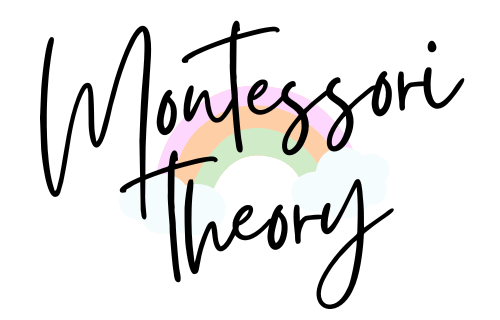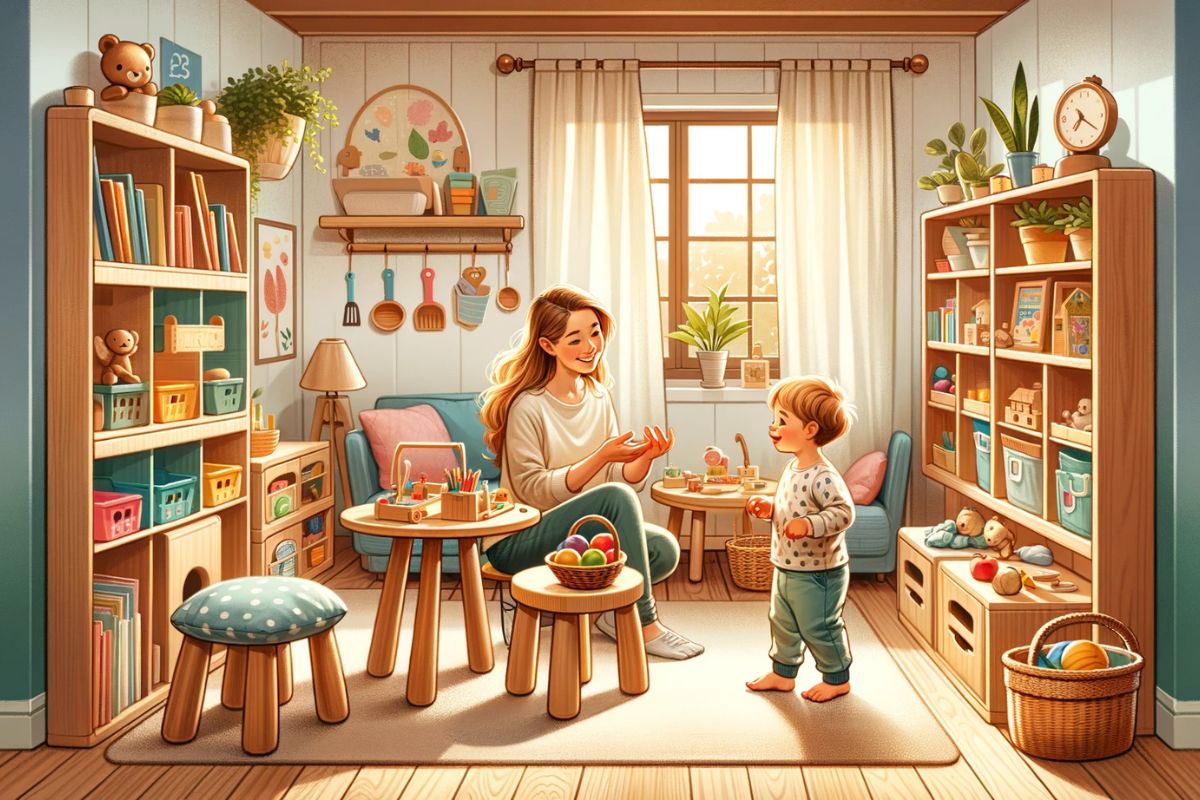Forget expensive toys and scripted curriculums – the seeds of your child’s genius already lie within, waiting to blossom in the right environment. Enter Montessori at home, an educational approach that celebrates child-led learning and transforms your everyday space into a nurturing springboard for curiosity, independence, and lifelong discovery. This isn’t just a trend, it’s a revolution in early childhood development, backed by decades of research
Why To Start Montessori at Home
Embarking on a Montessori-inspired journey within the home environment lays a robust foundation for lifelong learning and well-being. Here’s why embracing Montessori principles can be transformative for your child:
- Sharpened Cognitive Skills: Think critical thinking ninjas and problem-solving wizards. Montessori’s emphasis on hands-on exploration stimulates brain development, leading to stronger analytical abilities, memory, and creativity.
- Confidence Unleashed: Imagine a child not just capable, but brimming with self-reliance. Montessori cultivates inner-directed learning, fostering a sense of agency and independence that empowers children to tackle challenges with confidence.
- Sensory Superpowers: Montessori awakens the senses, from the smooth texture of wooden blocks to the vibrant hues of nature collages. Children develop heightened awareness of their surroundings, leading to improved fine motor skills and spatial reasoning.
- Empathy Blossoms: This isn’t a solo journey. Montessori encourages cooperative learning and respect for others, nurturing empathy and social responsibility. Your child will blossom into a kind and compassionate human being, ready to collaborate and contribute to the world.
The evidence supporting Montessori’s effectiveness is compelling, with numerous studies demonstrating its positive impact on children’s cognitive, social, and emotional development. For instance, a study published in the Frontiers in Psychology found that Montessori-educated children outperformed their traditional school counterparts on cognitive assessments. Additionally, a study published in the Journal of Early Childhood Research found that Montessori-educated children demonstrated higher levels of executive functioning skills, which are essential for complex thinking and problem-solving.
Let’s Create Your Own Montessori Haven!
Step 1: Craft a Prepared Environment – Not a Playground, but a Laboratory of Learning
Think less “jungle gym” and more “mini research lab.” The key is to deconstruct your space and reimagine it through your child’s eyes. Here are your guiding principles:
- Accessibility Is Key: Ditch high shelves and locked cabinets. Arrange Montessori-approved materials on low, open shelves to empower self-directed exploration.
- Natural Materials Reign Supreme: Plastic dinosaurs? Swap them for wooden blocks and textured fabrics. Embrace nature’s sensory symphony with plants, sand trays, and water play areas.
- Age-Appropriate Adventures: Cater to your child’s evolving interests. Rotate materials regularly, offering new challenges and keeping the spark of curiosity alive.
- Less is More: Declutter! A minimalist aesthetic reduces distractions and promotes focus on the activity at hand.
Step 2: Everyday Tasks Become Epic Quests – Practical Life Skills Take Center Stage
Montessori believes learning isn’t confined to textbooks. Everyday chores become opportunities for growth and empowerment. Here’s how to turn mundane tasks into magical moments:
- Dishwashing Dynamo: Provide a child-sized step stool and miniature dishware. Let them conquer those greasy plates with soapy suds and newfound independence.
- Dressing Dilemmas Solved: Choose clothes with easy-to-grasp zippers and buttons. Mastering dressing skills builds confidence and fosters a sense of accomplishment.
- Water-Pouring Wizardry: Equip your child with a small pitcher and cup. Learning to pour isn’t just about hydration, it’s about refining fine motor skills and coordination.
- Gardening Gurus: Let your little green thumbs sprout! Planting seeds, tending to seedlings, and witnessing the wonders of nature cultivate responsibility and nurture a connection to the world.
Step 3: Ignite the Curiosity Flame – Activities to Spark a Lifetime of Learning
Learning through play is the cornerstone of Montessori. No rote memorization here, just engaging activities that fuel your child’s inner explorer:
- Sensory Symphony: Fill trays with beans, rice, or sand for tactile exploration. Hide small objects for treasure hunts that engage sight, touch, and smell.
- Language Launchpad: Read aloud regularly, provide alphabet blocks and puzzles, and encourage storytelling. Let their imaginations soar with the wings of words.
- Math Masters in the Making: Counting apples in the grocery store, sorting laundry by color, baking cookies using fractions – everyday activities become stealthy math lessons.
- Artistic Expression Explodes: Unleash the inner Picasso with paints, crayons, and play dough. Open-ended art projects let creativity bloom without borders.
Step 4: Nurture a Growth Mindset – Celebrate the Journey, Not Just the Destination
Mistakes aren’t setbacks, they’re stepping stones! In Montessori, perfection takes a backseat to effort and progress. Here’s how to cultivate a supportive learning environment:
- Follow Your Child’s Lead: Observe their interests and tailor activities accordingly. Let curiosity be your compass.
- Guide, Don’t Control: Offer gentle support, not commands. Let them experiment, learn from mistakes, and
- discover their own path. Celebrate their efforts, not just the end result.
- Embrace Mistakes as Stepping Stones: Remember, the wobbly tower and spilled water are stepping stones, not failures. Encourage reflection and problem-solving to turn mistakes into learning opportunities.
- Focus on Effort and Progress: Applaud the attempt, not just the achievement. Celebrate perseverance and incremental progress, fostering a love of learning that transcends results.
- Respect Individuality: Every child is unique. Embrace their learning pace and learning style. Montessori isn’t about cookie-cutter education, it’s about nurturing each child’s individual potential.
Remember, your home is the launchpad for your child’s lifelong learning journey. By embracing the Montessori principles and creating a nurturing environment, you’re not just building a house, you’re building a world of possibilities. So, open the doors, unleash the wonder, and watch your child blossom into the confident, capable, and compassionate human being they’re meant to be.
Nurturing a Montessori Haven: Cultivating a Child-Centered Learning Sanctuary at Home
The Montessori approach to education revolves around creating a thoughtfully designed and nurturing environment that fosters a child’s natural inclination towards learning and exploration. By transforming your home into a Montessori haven, you can empower your child to embark on a lifelong journey of self-discovery and intellectual growth.
Creating a Montessori Home for Babies
Babies, with their insatiable curiosity and boundless energy, are natural explorers eager to navigate their surroundings. A Montessori-inspired home environment for babies can provide a safe and stimulating space where they can freely engage with their environment and develop their senses and physical skills.
- Embrace Floor Beds: In line with Montessori principles, consider transitioning your baby from a crib to a floor bed. This allows for unrestricted movement, promoting gross motor development and fostering a sense of independence.
- Create a Movement Oasis: Dedicate a soft and cozy area for your baby to engage in physical exploration. A play mat with various textures, such as fabrics and cushions, can stimulate their senses and encourage movement.
- Embrace Open-Access Storage: Replace traditional high cabinets with low shelves and baskets within reach of your baby. This promotes independence and allows them to access toys and materials whenever they desire.
- Surround with Natural Materials: Incorporate natural elements like wood, cotton, and wool into your baby’s environment. These materials foster a connection with nature and provide sensory engagement.
Nurturing a Montessori Home for Toddlers
As toddlers embark on their journey of independence and exploration, a Montessori home environment can nurture their curiosity and physical development.
- Provide Child-Sized Furniture: Equip your home with low tables and chairs that are appropriate for your toddler’s height. This encourages independent eating and encourages self-feeding skills.
- Dedicate a Movement Zone: Designate a space with soft mats, tunnels, and climbing equipment to stimulate gross motor development. This fosters physical coordination and promotes a love of movement.
- Incorporate Practical Life Activities: Encourage your toddler to engage in simple practical life activities using child-sized tools such as brooms and dustpans. This develops fine motor skills and promotes independence.
- Embrace Open-Shelf Organization: Utilize open shelves to display toys and materials that are easily accessible to your toddler. This fosters autonomy and allows them to choose their activities independently.
Nurturing a Montessori Home for School-Aged Children
School-aged children, with their growing intellect and social awareness, thrive in a Montessori home that provides opportunities for exploration, creativity, and self-directed learning.
- Establish a Designated Workspace: Create a designated workspace with a desk, chair, and supplies tailored to your child’s interests. This fosters focus and independent learning.
- Diversify Learning Materials: Provide a range of Montessori materials that cater to your child’s learning style, including science kits, math manipulatives, language tools, and cultural resources.
- Embrace Technology as a Resource: Teach your school-aged child responsible internet usage and guide them in finding reliable sources of information.
- Nurture Independence in Daily Activities: Encourage your child to take ownership of their learning and engage in real-life activities such as cooking and cleaning.
Montessori Materials and Activities to Use at Home
Montessori education is renowned for its emphasis on child-centered learning, fostering independence, and sensory exploration. The materials and activities employed in this approach are meticulously designed to cater to the developmental needs of children across various age groups, igniting their curiosity and propelling them towards a lifelong love of learning.
-
Practical Life Activities: Nurturing Fine Motor Skills and Independence
Practical life activities focus on developing fine motor skills, independence, and self-help skills. Children learn to perform everyday tasks that contribute to their daily lives.
| Age Group | Activities | Materials |
|---|---|---|
| Toddlers | Pouring, transferring, cleaning, setting the table | Water pitchers, blocks, bowls, cloths |
| Preschoolers | Dusting, washing dishes, folding laundry, dressing, putting on shoes | Dustpan, washcloth, laundry basket, clothespins, shoes |
| School-aged Children | Preparing simple meals, setting the table, cleaning up after meals, yard work | Measuring cups, spoons, bowls, plates, utensils, gardening tools |
-
Sensory Activities: Igniting Curiosity and Sensory Awareness
Montessori’s sensory approach awakens the senses, providing a rich and engaging learning environment. Sensory activities engage all five senses and promote exploration, creativity, and problem-solving skills. Children learn about the properties of different materials and how they can be used in different ways.
| Age Group | Activities | Materials |
|---|---|---|
| Babies | Exploring textures, sounds, water play | Soft fabrics, rattles, water trays, sand, clay |
| Toddlers | Sorting, identifying colors and shapes, exploring scents | Pasta shapes, color cards, spice jars, herb packets |
| Preschoolers | Color combinations, sensory bins, puzzles, shapes, textures | Fabric swatches, sensory play dough, natural materials like pinecones and rocks |
| School-aged Children | Sensory bins, science experiments, blindfold drawing, taste tests | Variety of tactile materials, experiment kits, art supplies, tasting sets |
-
Language Activities: Fostering Communication and Storytelling
Language activities promote communication, storytelling, and creativity. Children learn to express themselves verbally and nonverbally, and they develop an appreciation for language and literature.
| Age Group | Activities | Materials |
|---|---|---|
| Toddlers | Listening, singing, imitating, rhyming, babbling | Storybooks, music, sound-making toys |
| Preschoolers | Conversations, descriptive language, questions, stories, poems, puppets | Picture books, storytelling props, puppet theater |
| School-aged Children | Writing stories, journaling, presentations, dramatic play, poems, scripts | Journals, pencils, costumes, stage |
-
Math Activities: Unveiling Mathematical Concepts Through Playful Engagement
Montessori’s math activities ignite a love for mathematics, introducing concepts through hands-on, engaging experiences. Math activities introduce children to the basic concepts of counting, numbers, shapes, and patterns. Children develop their mathematical thinking and problem-solving skills.
| Age Group | Activities | Materials |
|---|---|---|
| Toddlers | Counting, color and shape identification, patterns, sorting | Counting blocks, shape sorters, simple puzzles |
| Preschoolers | Counting objects, identifying numbers, using manipulatives, recognizing patterns, addition, subtraction | Bead strings, number flashcards, simple math workbooks |
| School-aged Children | Number games, hundred board, complex math problems, fractions, decimals | Math board games, hundred charts, fraction tiles, decimal boards |
-
Cultural Activities: Expanding Horizons and Fostering Understanding
Montessori cultivates a sense of global citizenship by exposing children to diverse cultures. Cultural activities expand children’s horizons and foster understanding of diverse cultures. Children learn about different languages, customs, and traditions.
| Age Group | Activities | Materials |
|---|---|---|
| Toddlers | Music, pictures, foods | Toy instruments, cultural picture books, play food sets |
| Preschoolers | Holidays, dress-up, role-playing | Holiday-specific decorations, cultural dress-up clothing, world maps |
| School-aged Children | Books, languages, community events, research | Multicultural books, language learning software, community cultural event flyers |
Simple Tips to Nurture a Curious Learner
As a Montessori parent, your role is to support your child’s natural curiosity, creativity, and independence. Montessori education is based on the belief that children have an innate desire to learn and that the role of adults is to guide and facilitate their learning.
- Embrace the Spirit of Montessori: Cultivate an environment that fosters independence, curiosity, and respect for children’s unique learning styles.
- Be Observant and Adaptable: Recognize your child’s interests and pace, adapting Montessori principles to their individual needs and development.
- Transform Everyday Moments: Turn mundane tasks into engaging learning opportunities, using language, choice, and active participation to enhance understanding.
- Create a Stimulating Haven: Designate a learning space with age-appropriate materials, fostering exploration, problem-solving, and sensory development.
- Embrace Nature’s Wisdom: Encourage outdoor play, immersing children in nature’s wonders, deepening their connections to the world around them.
- Involve Your Little Helper: Engage your child in age-appropriate household chores, fostering responsibility, teamwork, and a sense of community.
- Value Mistakes as Stepping Stones: Mistakes are crucial for growth. Reframe them as learning opportunities, fostering resilience and adaptability.
- Nurture Social and Emotional Growth: Encourage interactions, emotional expression, empathy, and positive relationships with others.
- Embrace Patience and Consistency: Implementing Montessori takes time and effort. Stay patient, consistent, and supportive in your approach.






